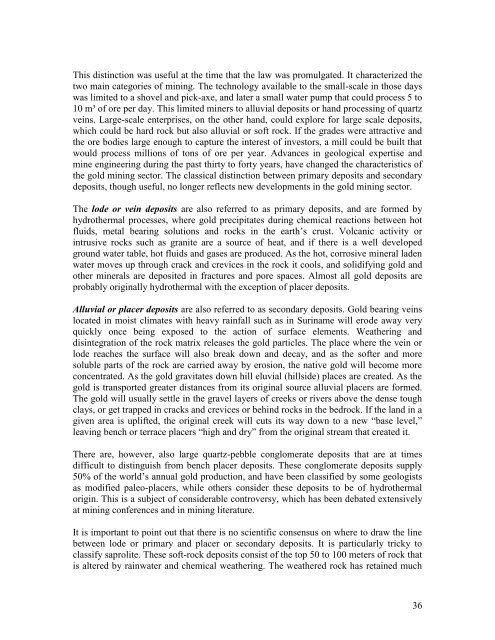SITUATION ANALYSIS OF THE SMALL-SCALE GOLD ... - WWF
SITUATION ANALYSIS OF THE SMALL-SCALE GOLD ... - WWF
SITUATION ANALYSIS OF THE SMALL-SCALE GOLD ... - WWF
Create successful ePaper yourself
Turn your PDF publications into a flip-book with our unique Google optimized e-Paper software.
This distinction was useful at the time that the law was promulgated. It characterized the<br />
two main categories of mining. The technology available to the small-scale in those days<br />
was limited to a shovel and pick-axe, and later a small water pump that could process 5 to<br />
10 m³ of ore per day. This limited miners to alluvial deposits or hand processing of quartz<br />
veins. Large-scale enterprises, on the other hand, could explore for large scale deposits,<br />
which could be hard rock but also alluvial or soft rock. If the grades were attractive and<br />
the ore bodies large enough to capture the interest of investors, a mill could be built that<br />
would process millions of tons of ore per year. Advances in geological expertise and<br />
mine engineering during the past thirty to forty years, have changed the characteristics of<br />
the gold mining sector. The classical distinction between primary deposits and secondary<br />
deposits, though useful, no longer reflects new developments in the gold mining sector.<br />
The lode or vein deposits are also referred to as primary deposits, and are formed by<br />
hydrothermal processes, where gold precipitates during chemical reactions between hot<br />
fluids, metal bearing solutions and rocks in the earth‟s crust. Volcanic activity or<br />
intrusive rocks such as granite are a source of heat, and if there is a well developed<br />
ground water table, hot fluids and gases are produced. As the hot, corrosive mineral laden<br />
water moves up through crack and crevices in the rock it cools, and solidifying gold and<br />
other minerals are deposited in fractures and pore spaces. Almost all gold deposits are<br />
probably originally hydrothermal with the exception of placer deposits.<br />
Alluvial or placer deposits are also referred to as secondary deposits. Gold bearing veins<br />
located in moist climates with heavy rainfall such as in Suriname will erode away very<br />
quickly once being exposed to the action of surface elements. Weathering and<br />
disintegration of the rock matrix releases the gold particles. The place where the vein or<br />
lode reaches the surface will also break down and decay, and as the softer and more<br />
soluble parts of the rock are carried away by erosion, the native gold will become more<br />
concentrated. As the gold gravitates down hill eluvial (hillside) places are created. As the<br />
gold is transported greater distances from its original source alluvial placers are formed.<br />
The gold will usually settle in the gravel layers of creeks or rivers above the dense tough<br />
clays, or get trapped in cracks and crevices or behind rocks in the bedrock. If the land in a<br />
given area is uplifted, the original creek will cuts its way down to a new “base level,”<br />
leaving bench or terrace placers “high and dry” from the original stream that created it.<br />
There are, however, also large quartz-pebble conglomerate deposits that are at times<br />
difficult to distinguish from bench placer deposits. These conglomerate deposits supply<br />
50% of the world‟s annual gold production, and have been classified by some geologists<br />
as modified paleo-placers, while others consider these deposits to be of hydrothermal<br />
origin. This is a subject of considerable controversy, which has been debated extensively<br />
at mining conferences and in mining literature.<br />
It is important to point out that there is no scientific consensus on where to draw the line<br />
between lode or primary and placer or secondary deposits. It is particularly tricky to<br />
classify saprolite. These soft-rock deposits consist of the top 50 to 100 meters of rock that<br />
is altered by rainwater and chemical weathering. The weathered rock has retained much<br />
36
















